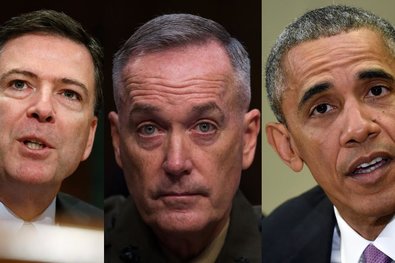
What’s the Greatest Threat to U.S. National Security?
Last month, Gen. Joseph Dunford, the incoming chairman of the Joint Chiefs of Staff, told the Senate that Russia presented the greatest threat to United States national security. At around the same time, James Comey, the F.B.I. director, declared the Islamic State to be the biggest threat. President Obama has consistently said that nuclear terrorism is what keeps him up at night. Who, or what, threatens America the most?
* incoming = 새로 당선[선출]된/ the Joint Chiefs of Staff = (미국의) 합동 참모 본부/ national security = 국가 안보/ nuclear terrorism = 핵 테러리즘/ keep sb up = ~를 잠자리에 들지 못하게 하다
 누가 또는 무엇이 미국을 가장 위협하나요?
누가 또는 무엇이 미국을 가장 위협하나요?
1. The Biggest Threat Are Internal Divisions
Political disagreements make the U.S. less reliable, leading friends to take matters into their own hands and foes to challenge U.S. policy, thinking they have little to fear.
2. America’s Mindset Could Be the Real Problem
The U.S. should adopt a narrower conception of its strategic priorities by focusing on Asia and recognizing the limits to its influence in the Middle East.
3. Migrant Flows Could Lead to a Threat From the Right
Immigration is not so much the threat as is the reaction of xenophobes, and the way mainstream parties placate them.
4. Climate Change Threatens Security at Home and Abroad
It will create instability over crops and water sources. It will destabilize the Arctic and even threaten the preparedness of our troops.
5. There’s No Contest. Russia and ISIS Are Most Threatening
The two broad strategic propositions that can help guide effective U.S. national security planning are to remember that potential threats are additive and unpredictable.
Sample Essay
There’s No Contest. Russia and ISIS Are Most Threatening
Significant potential threats to U.S. interests today include nation-state challenges such as those posed by China, Iran, North Korea and Russia, and those posed by nonstate actors such as Al Qaeda, Hezbollah, ISIS, and the many individuals and groups worldwide who are directed or inspired by such extremist groups. The U.S. does not need to, nor can it, prepare for all of the worst-case scenarios that might emerge from this entire lineup simultaneously.
Nonetheless, two broad strategic propositions can help guide effective U.S. national security planning:
1. Potential threats are additive. The U.S. must continuously update its assessments of their evolution, the national security stakes for the U.S. and its allies, and how best to prepare to address the threats using a “portfolio approach.” Such an approach calls for the U.S. military engaging with allies and partners in key regions (including exercises and training) to prepare for near-term crises and attacks, while also investing in future military capabilities to help ensure success in future contingencies.
2. These, and other potential threats, are increasingly unpredictable. We live in a new age of major, dynamic changes unfolding across the globe, including the growth of disruptive technologies and urbanization. This dynamism, combined with the growing power of nonstate actors, makes threat prediction even more difficult than previously (and historically, the U.S. often has been surprised by major new security developments including the 9/11 attacks and the Arab Spring in recent years and the end of the Cold War and Pearl Harbor in the last century). Thus, while the U.S. must prioritize among threats and allocate resources accordingly, it must be agile and responsive to inevitable strategic shocks when they arise, which they will.
With those caveats in mind, the two most urgent national security threats today are: The threat of military conflict with Russia, potentially triggered by Russian-fomented instability in a NATO nation or Russian military aircraft flying into a civilian airliner (they have been flying close to civilian aircraft with their transponders off). And second, the high probability of larger-scale, successful ISIS-inspired attacks in the U.S., a threat continuously incubated by the Syrian and Iraqi civil wars.
Both of these threats are here and now, and could emerge, literally, tomorrow.





![]() 누가 또는 무엇이 미국을 가장 위협하나요?
누가 또는 무엇이 미국을 가장 위협하나요?






